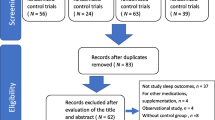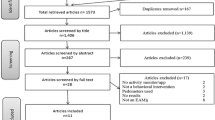Abstract
Purpose of Review
This review explored the characteristics of interventions that use wearable activity monitors (WAM) and descriptively summarize their efficacy.
Recent Findings
A total of 61 studies were included. Most of the WAM-based interventions (n = 58) were designed to improve physical activity (PA). Interventions targeting sedentary behavior (SB) were much less common (n = 12), and even less frequent were WAM-based sleep interventions (n = 3). Most studies tested the feasibility of WAM-based interventions. WAM-based interventions exhibited preliminary efficacy in increasing PA and potential in decreasing sedentary time. More evidence are needed to determine the utility of WAM in improving sleep.
Summary
The efficacy of interventions using WAM to improve PA, SB, and/or sleep could not be conclusively determined. Major challenges with including WAM as part of interventions are reduced engagement with the devices over time, and the rapid changes in technology resulting in devices becoming obsolete soon after completion of an efficacy trial.

Similar content being viewed by others
References
Papers of particular interest, published recently, have been highlighted as: • Of importance •• Of major importance
Wright SP, et al. How consumer physical activity monitors could transform human physiology research. Am J Physiol Regul Integr Comp Physiol. 2017;312(3):R358–67.
International Data Corportation, Wrist-worn wearables maintain a strong growth trajectory in Q2 2019, according to IDC. 2019, Press release from IDC on September 12, 2019. .
Omura JD, et al. National physical activity surveillance: users of wearable activity monitors as a potential data source. Prev Med Rep. 2017;5:124–6.
Henriksen A, Haugen Mikalsen M, Woldaregay AZ, Muzny M, Hartvigsen G, Hopstock LA, et al. Using fitness trackers and smartwatches to measure physical activity in research: analysis of consumer wrist-worn wearables. J Med Internet Res. 2018;20(3):e110.
Straiton N, Alharbi M, Bauman A, Neubeck L, Gullick J, Bhindi R, et al. The validity and reliability of consumer-grade activity trackers in older, community-dwelling adults: a systematic review. Maturitas. 2018;112:85–93.
Evenson KR, Goto MM, Furberg RD. Systematic review of the validity and reliability of consumer-wearable activity trackers. Int J Behav Nutr Phys Act. 2015;12:159.
Kang SG, Kang JM, Ko KP, Park SC, Mariani S, Weng J. Validity of a commercial wearable sleep tracker in adult insomnia disorder patients and good sleepers. J Psychosom Res. 2017;97:38–44.
de Zambotti M, et al. Wearable sleep technology in clinical and research settings. Med Sci Sports Exerc. 2019;51(7):1538–57.
de Bruin E, Hartmann A, Uebelhart D, Murer K, Zijlstra W. Wearable systems for monitoring mobility-related activities in older people: a systematic review. Clin Rehabil. 2008;22:878–95.
Ridgers ND, McNarry MA, Mackintosh KA. Feasibility and effectiveness of using wearable activity trackers in youth: a systematic review. JMIR Mhealth Uhealth. 2016;4(4):e129.
Tricco AC, Lillie E, Zarin W, O'Brien KK, Colquhoun H, Levac D, et al. PRISMA extension for scoping reviews (PRISMA-ScR): checklist and explanation. Ann Intern Med. 2018;169(7):467–73.
Evans EW, et al. Using novel technology within a school-based setting to increase physical activity: a pilot study in school-age children from a low-income, urban community. Biomed Res Int. 2017;2017:1–7.
Cadmus-Bertram LA, Marcus BH, Patterson RE, Parker BA, Morey BL. Randomized trial of a Fitbit-based physical activity intervention for women. Am J Prev Med. 2015;49(3):414–8.
Cadmus-Bertram L, et al. Use of the Fitbit to measure adherence to a physical activity intervention among overweight or obese, postmenopausal women: self-monitoring trajectory during 16 weeks. J Med Internet Res. 2015;17(11):1–1.
Sloan RA, Kim Y, Sahasranaman A, Müller-Riemenschneider F, Biddle SJH, Finkelstein EA. The influence of a consumer-wearable activity tracker on sedentary time and prolonged sedentary bouts: secondary analysis of a randomized controlled trial. BMC Res Notes. 2018;11(1):189.
• Finkelstein EA, et al. Effectiveness of activity trackers with and without incentives to increase physical activity (TRIPPA): a randomised controlled trial. Lancet Diabetes Endocrinol. 2016;4(12):983–95 A large randomized controlled trial (RCT) that compared the impact of WAM with or without modest incentives on physical activity (PA) in generally healthy adults. Cash incentive with WAM was most effective in increasing PA; however, this effect was not sustained. This study exemplifies the challenge of sustained device engagement that plagued several WAM-based interventions.
Phillips CB, et al. Delay discount rate moderates a physical activity intervention testing immediate rewards. Behav Med. 2019.
Adams MA, Hurley JC, Todd M, Bhuiyan N, Jarrett CL, Tucker WJ, et al. Adaptive goal setting and financial incentives: a 2×2 factorial randomized controlled trial to increase adults’ physical activity. BMC Public Health. 2017;17(1):286.
Meints SM, Yang HY, Collins JE, Katz JN, Losina E. Race differences in physical activity uptake within a workplace wellness program: a comparison of black and white employees. Am J Health Promot. 2019;33(6):886–93.
Losina E, et al. Implementation of a workplace intervention using financial rewards to promote adherence to physical activity guidelines: a feasibility study. BMC Public Health. 2017;17:1–9.
Barwais FA, Cuddihy TF. Empowering sedentary adults to reduce sedentary behavior and increase physical activity levels and energy expenditure: a pilot study. Int J Environ Res Public Health. 2015;12(1):414–27.
Abrantes AM, Blevins CE, Battle CL, Read JP, Gordon AL, Stein MD. Developing a Fitbit-supported lifestyle physical activity intervention for depressed alcohol dependent women. J Subst Abus Treat. 2017;80:88–97.
• Cadmus-Bertram L, et al. Building a physical activity intervention into clinical care for breast and colorectal cancer survivors in Wisconsin: a randomized controlled pilot trial. J Cancer Surviv. 2019;13(4):593–602 A pilot study that tested the impact of a multicomponent WAM-based intervention on PA in cancer survivors. The intervention led to significant increase in PA. This study exemplifies the feasibility of WAM-based PA interventions for individuals with health conditions.
Poirier J, Bennett WL, Jerome GJ, Shah NG, Lazo M, Yeh HC, et al. Effectiveness of an activity tracker- and internet-based adaptive walking program for adults: a randomized controlled trial. J Med Internet Res. 2016;18(2):e34.
Muellmann S, et al. Effects of two web-based interventions promoting physical activity among older adults compared to a delayed intervention control group in Northwestern Germany: results of the PROMOTE community-based intervention trial. Prev Med Rep. 2019;15.
Choi J, Lee JH, Vittinghoff E, Fukuoka Y. mHealth physical activity intervention: a randomized pilot study in physically inactive pregnant women. Matern Child Health J. 2016;20(5):1091–101.
Amorim, A.B., et al., Integrating mobile-health, health coaching, and physical activity to reduce the burden of chronic low back pain trial (IMPACT): a pilot randomised controlled trial. BMC Musculoskelet Disord, 2019. 20(1).
Deka P, Pozehl B, Williams MA, Norman JF, Khazanchi D, Pathak D. MOVE-HF: an internet-based pilot study to improve adherence to exercise in patients with heart failure. Eur J Cardiovasc Nurs. 2019;18(2):122–31.
Adams MA, et al. Adaptive goal setting and financial incentives: a 2×2 factorial randomized controlled trial to increase adults physical activity. BMC Public Health. 2017;17:1–16.
Patel MS, Benjamin EJ, Volpp KG, Fox CS, Small DS, Massaro JM, et al. Effect of a game-based intervention designed to enhance social incentives to increase physical activity among families: the BE FIT randomized clinical trial. JAMA Intern Med. 2017;177(11):1586–93.
Chokshi NP, et al. Loss-framed financial incentives and personalized goal-setting to increase physical activity among ischemic heart disease patients using wearable devices: the ACTIVE REWARD randomized trial. J Am Heart Assoc. 2018;7(12):1–10.
Garde A, Umedaly A, Abulnaga SM, Robertson L, Junker A, Chanoine JP, et al. Assessment of a mobile game (“MobileKids Monster Manor”) to promote physical activity among children. Games Health J. 2015;4(2):149–58.
• Garde A, et al. Evaluation of a novel mobile exergame in a school-based environment. Cyberpsychol Behav Soc Netw. 2016;19(3):186–92 A novel study that tested the impact of exergaming, which combines PA with electronic games, in children. Participants earned “game time” by engaging in PA. The intervention led to significant increase in PA. This study exemplifies the feasibility of WAM-based interventions in children.
Gremaud AL, et al. Gamifying accelerometer use increases physical activity levels of sedentary office workers. J Am Heart Assoc. 2018;7(13):1–12.
Chung AE, et al. Tweeting to health: a novel mHealth intervention using Fitbits and twitter to foster healthy lifestyles. Clin Pediatr. 2017;56(1):26–32.
Shin DW, et al. Enhancing physical activity and reducing obesity through smartcare and financial incentives: a pilot randomized trial. Obesity (19307381). 2017;25(2):302–10.
Barwais FA, Cuddihy TF, Tomson LM. Physical activity, sedentary behavior and total wellness changes among sedentary adults: a 4-week randomized controlled trial. Health Qual Life Outcomes. 2013;11(183):1–8.
Vandelanotte C, et al. The effectiveness of a web-based computer-tailored physical activity intervention using Fitbit activity trackers: randomized trial. J Med Internet Res. 2018;20(12):30–0.
Janevic MR, et al. Acceptability and effects of commercially available activity trackers for chronic pain management among older African American adults. Pain Med. 2019.
Polgreen LA, Anthony C, Carr L, Simmering JE, Evans NJ, Foster ED, et al. The effect of automated text messaging and goal setting on pedometer adherence and physical activity in patients with diabetes: a randomized controlled trial. PLoS One. 2018;13(5):e0195797.
Melton BF, et al. Wearable devices to improve physical activity and sleep. J Black Stud. 2016;47(6):610–25.
Crowley O, Pugliese L, Kachnowski S. The impact of wearable device enabled health initiative on physical activity and sleep. Cureus. 2016;8(10):e825.
Hooke MC, Gilchrist L, Tanner L, Hart N, Withycombe JS. Use of a fitness tracker to promote physical activity in children with acute lymphoblastic leukemia. Pediatr Blood Cancer. 2016;63(4):684–9.
Gell NM, Grover KW, Humble M, Sexton M, Dittus K. Efficacy, feasibility, and acceptability of a novel technology-based intervention to support physical activity in cancer survivors. Support Care Cancer. 2017;25(4):1291–300.
Pope, Z.C., et al., Effectiveness of combined smartwatch and social media intervention on breast cancer survivor health outcomes: a 10-week pilot randomized trial. J Clin Med, 2018. 7(6).
Trinh, L., et al., RiseTx: testing the feasibility of a web application for reducing sedentary behavior among prostate cancer survivors receiving androgen deprivation therapy. International Journal of Behavioral Nutrition & Physical Activity, 2018. 15(1): p. N.PAG-N.PAG.
Olsen HM, et al. A brief self-directed intervention to reduce office employees’ sedentary behavior in a flexible workplace. J Occup Environ Med. 2018;60(10):954–9.
Gilson ND, et al. The impact of an m-health financial incentives program on the physical activity and diet of Australian truck drivers. BMC Public Health. 2017;17:1–11.
Hacker ED, Peters T, Patel P, Rondelli D. Steps to enhance early recovery after hematopoietic stem cell transplantation: lessons learned from a physical activity feasibility study. Clinical nurse specialist CNS. 2018;32(3):152–62.
Sloan RA, et al. The influence of a consumer-wearable activity tracker on sedentary time and prolonged sedentary bouts: secondary analysis of a randomized controlled trial. BMC research notes. 2018;11(1):189.
Buchele, H. and W. Chen, Technology-enhanced classroom activity breaks impacting children’s physical activity and fitness. J Clin Med, 2018. 7(7).
Ezeugwu VE, Manns PJ. The feasibility and longitudinal effects of a home-based sedentary behavior change intervention after stroke. Arch Phys Med Rehabil. 2018;99(12):2540–7.
Lynch, B.M., et al., Maintenance of physical activity and sedentary behavior change, and physical activity and sedentary behavior change after an abridged intervention: secondary outcomes from the ACTIVATE Trial. Cancer (0008543X), 2019. 125(16): p. 2856–2860.
• Choi JY, Chang AK, Choi EJ. Effects of a physical activity and sedentary behavior program on activity levels, stress, body size, and sleep in sedentary Korean college students. Holist Nurs Pract. 2018;32(6):287–95 A quasi-experimental study that examined the effect of a WAM-based intervention on PA, sedentary behavior, and sleep. The intervention led to significant increase in PA, a significant decrease in sedentary time, and a non-significant increase in sleep duration.
• Kang SG, et al. Cognitive behavioral therapy using a mobile application synchronizable with wearable devices for insomnia treatment: a pilot study. J Clin Sleep Med. 2017;13(4):633–40 A pilot study that tested the efficacy of a technology-based sleep intervention and the only one that focused on individuals with insomnia. The WAM was used to objectively track sleep which was then used to inform the sleep prescription by the therapist.
Shin G, et al. Beyond novelty effect: a mixed-methods exploration into the motivation for long-term activity tracker use. JAMIA Open. 2019;2(1):62–72.
Cohen J, Torous J. The potential of object-relations theory for improving engagement with health apps. JAMA. 2019:E1–2.
Pellegrini CA, Steglitz J, Hoffman SA. E-health intervention development: a synopsis and comment on “what design features are used in effective e-health interventions? A review using techniques from critical interpretive synthesis”. Transl Behav Med. 2014;4(4):342–5.
Nahum-Shani I, Qian M, Almirall D, Pelham WE, Gnagy B, Fabiano GA, et al. Experimental design and primary data analysis methods for comparing adaptive interventions. Psychol Methods. 2012;17(4):457–77.
Acknowledgments
We would like to thank our reference librarian, Rebecca Raszewksi, MS, AHIP at the University of Illinois, Chicago, for her assistance in developing the electronic search strategy.
Author information
Authors and Affiliations
Corresponding author
Ethics declarations
Conflict of Interest
Drs. Kline and Burke report grants from the National Institutes of Health outside of the submitted work. The other authors declare no conflicts of interest.
Human and Animal Rights
This article does not contain any studies with human or animal subjects performed by any of the authors.
Additional information
Publisher’s Note
Springer Nature remains neutral with regard to jurisdictional claims in published maps and institutional affiliations.
Electronic supplementary material
ESM 1
(DOCX 19 kb)
Rights and permissions
About this article
Cite this article
Cajita, M.I., Kline, C.E., Burke, L.E. et al. Feasible but Not Yet Efficacious: a Scoping Review of Wearable Activity Monitors in Interventions Targeting Physical Activity, Sedentary Behavior, and Sleep. Curr Epidemiol Rep 7, 25–38 (2020). https://doi.org/10.1007/s40471-020-00229-2
Published:
Issue Date:
DOI: https://doi.org/10.1007/s40471-020-00229-2




